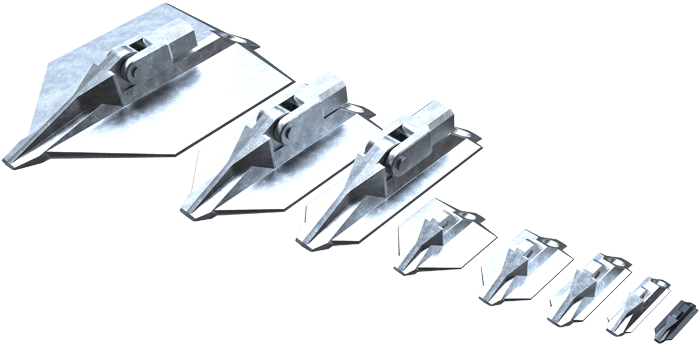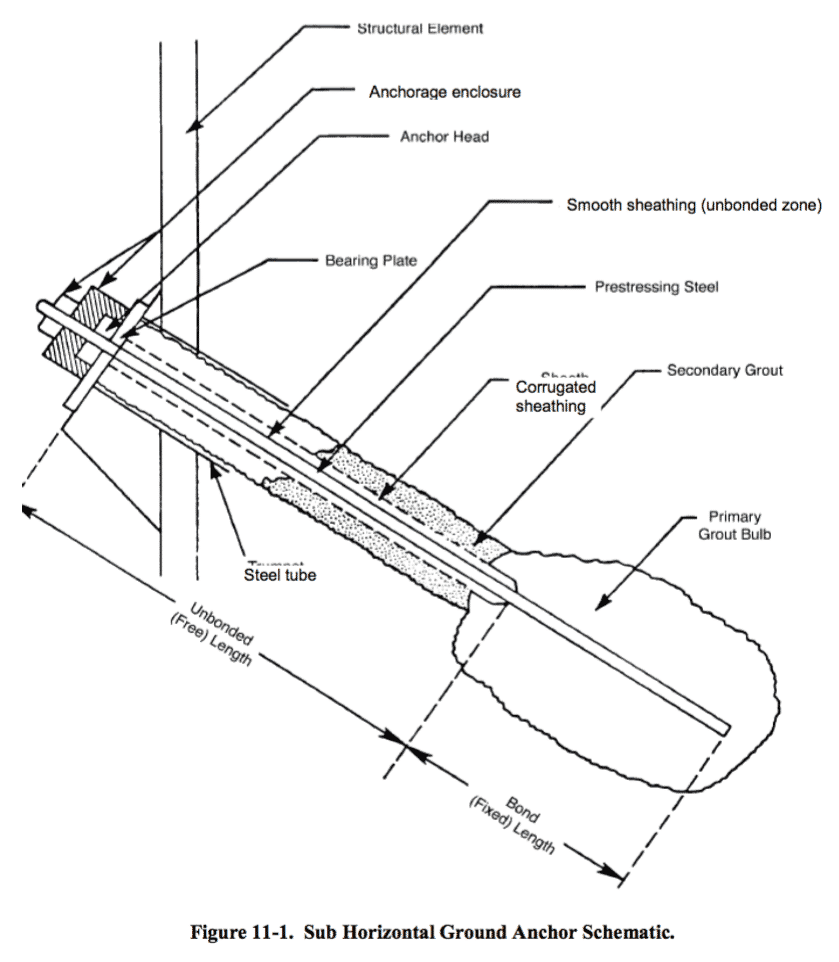Exactly How Heavy-Duty Earth Anchors Job: A Comprehensive Guide to Dirt Anchoring Solutions
Durable Earth anchors play a crucial role in giving security and assistance in different construction applications. By embedding deeply into the ground, they withstand lateral and vertical forces properly. Different kinds of anchors deal with various dirt problems, making them functional. Comprehending their technicians and installation methods is necessary for taking full advantage of efficiency. What factors affect their efficiency, and just how do they contrast to conventional techniques? The answers may shock you.
Understanding Heavy-Duty Earth Anchors
Sturdy Earth anchors offer as crucial components in numerous construction and landscaping jobs, supplying stability and support in difficult dirt conditions. These supports function by being embedded into the ground, where they resist lateral and upright pressures. Their style enables secure attachment to structures, ensuring they remain anchored against soil motion or external loads.The effectiveness of durable Earth anchors mostly depends upon the sort of dirt and the support's setup depth. Proper setup techniques are vital, as they identify the support's holding capability. Environmental elements, such as moisture and freeze-thaw cycles, can additionally influence performance.These supports are regularly utilized in applications ranging from securing fencings and preserving wall surfaces to stabilizing momentary frameworks during unfavorable weather problems. Understanding the concepts behind durable Earth anchors is important for experts seeking to boost the longevity and safety and security of their tasks.
Kinds Of Heavy-Duty Earth Anchors
Different kinds of sturdy Earth anchors are designed to fulfill certain demands based upon soil conditions and task requirements. Helical anchors, including screw-like blades, work in softer dirts, using high tons capabilities and easy installment. Driven anchors, which are inculcated the ground, appropriate for rocky surfaces and offer prompt load assistance. Tie-back anchors are commonly made use of in preserving wall surface applications, permitting side support by securing right into the ground at an angle. One more kind is the cast-in-place support, ideal for concrete applications, as they are incorporated right into foundations for boosted security. Dirt screw supports are versatile choices that can be used in different dirt kinds, giving reputable stress and compression capabilities. Each type offers distinct applications, making sure security and safety in construction and landscape design projects. Comprehending these alternatives permits notified choices in selecting the suitable Earth anchoring service.
The Mechanics of Dirt Anchoring

Recognizing the mechanics of soil anchoring needs an examination of different sorts of Earth supports and their installment methods. Each support kind offers unique characteristics that influence its efficiency in various dirt problems. Proper setup techniques are crucial for optimizing the anchoring system's stability and performance.
Sorts Of Earth Anchors
Earth anchors, crucial parts in dirt anchoring systems, can be found in numerous kinds, each developed for certain applications and dirt problems. The most typical kinds consist of screw anchors, which are twisted right into the ground, providing solid side resistance. Helical supports include blades that permit efficient installation in numerous dirt kinds, making them ideal for both long-term and short-lived applications. Driven supports, typically made from steel, are inculcated the dirt and work in rough or dense environments. Auger supports utilize a helical layout to promote setup in softer dirts. Plate supports are composed of a flat plate hidden horizontally, distributing load over a bigger area, ideal for applications needing high tons capacities in natural soils.
Installment Methods Discussed
Proper setup methods are crucial for the efficiency of dirt anchoring systems. The process generally starts with site analysis, verifying the picked location can sustain the anchor's lots. After figuring out the correct anchor kind, appropriate opening depth and angle should be established. The installment involves driving the anchor right into the ground making use of specific tools, such as hydraulic or hands-on drivers, to attain best embedment. Post-installation, tensioning the support is crucial to ensure stability; this is often verified with tons screening. Furthermore, surrounding soil problems need to be kept track of to protect against displacement. Complying with these strategies not only enhances the support's efficiency yet also prolongs its life expectancy, giving reputable assistance for numerous applications.
Applications of Heavy-Duty Earth Anchors
While sturdy Earth anchors are commonly linked with construction and landscape design, their flexibility includes a selection of applications throughout various sectors. In civil engineering, they offer necessary assistance for preserving walls, making sure stability in areas susceptible to dirt disintegration. The marine industry utilizes these supports for securing docks and marinas, protecting against motion brought on by currents and tides. In addition, in the telecom sector, durable Earth supports are significant for maintaining cell towers and other high frameworks against wind forces. Agricultural applications also benefit, as these anchors can protect structures like greenhouses and animals fence, guaranteeing they endure rough weather. Additionally, in eco-friendly energy jobs, such as wind ranches, Earth supports play a vital duty in securing turbine structures, boosting overall safety and security and efficiency. This wide series of applications highlights the adaptability and reliability of sturdy Earth anchors throughout numerous fields.
Advantages Over Traditional Anchoring Methods
Although conventional anchoring techniques have long been trusted for stability, heavy-duty Earth supports provide significant benefits that improve efficiency and efficiency. One significant benefit is their exceptional load-bearing ability, which enables them to withstand greater pressures without failing. This toughness makes them excellent for requiring applications, such as in building and utility installations.Additionally, sturdy Earth anchors are made for deeper setup, giving greater security in different soil problems, including sandy or loosened soils. Their resistance to rust and ecological elements ensures a longer life-span and lowered upkeep costs compared to standard methods.Moreover, these supports can be mounted with very little disturbance to the surrounding location, preserving the honesty of the landscape. In general, sturdy Earth anchors offer a trustworthy and effective remedy for anchoring needs, view it exceeding the constraints usually associated with conventional anchoring methods.
Setup Process and Finest Practices
The installation procedure for soil securing options starts with complete prep work and website analysis to ensure peak efficiency. Following this, a step-by-step installation guide offers clear directions for reliable execution (Manta Ray anchors). Adhering to these ideal practices is vital for achieving durable and trustworthy anchoring results
Preparation and Website Analysis
Efficient preparation and complete site evaluation are crucial steps in the setup of soil securing services. Prior to installment, the soil kind must be examined to establish its bearing capability and viability for anchoring. Carrying out a geotechnical study can offer important info about dirt composition, wetness levels, and possible ground motion. In addition, recognizing existing frameworks, vegetation, and utilities is important to avoid interference throughout installment. The location ought to be cleared of debris and barriers to assure risk-free gain access to for tools. Weather must also be kept track of, as unfavorable problems can impact both safety and security and setup effectiveness. By thoroughly preparing the website and evaluating all relevant elements, the probability of effective support efficiency is significantly boosted.
Step-by-Step Setup Guide
A complete installation procedure is vital for attaining suitable performance of soil anchoring solutions. The installation starts with picking the proper anchor type and assuring the website is free from debris. Next off, correct opening positioning is identified based upon lots demands. Once the area is established, openings are pierced to the defined depth and diameter utilizing the appropriate tools. The anchor is then put right into the hole, ensuring it is aligned correctly. After protecting the support, soil is backfilled and compacted to boost security. It is vital to follow producer standards throughout the procedure. A post-installation examination verifies that the supports are properly positioned and operating as planned, supplying trusted support for the designated application.

Upkeep and Evaluation of Earth Anchors
Regular maintenance and inspection of Earth anchors are essential for making sure lasting efficiency and security. Periodic checks enable the early detection of concerns such as corrosion, loosening up, or More hints dirt movement. Inspectors should seek signs of rust or destruction on the support parts, especially at the link factors. In addition, the surrounding soil needs to be evaluated for disintegration or changes in wetness web content, which can influence support effectiveness.It is recommended to develop a regular inspection routine, ideally at the very least as soon as a year, depending upon environmental problems. During examinations, all noticeable components ought to be cleaned up to remove dust or particles that can hide potential troubles. Any indications of distress, such as turning frameworks or uncommon settling, ought to motivate instant evaluation. Proper paperwork of inspections can help in monitoring support efficiency over time and assist in prompt upkeep activities, making sure the anchors continue to be dependable and practical.
Regularly Asked Questions
What Materials Are Heavy-Duty Earth Anchors Generally Made From?
Sturdy Earth supports are usually constructed from durable products such as galvanized steel or stainless-steel, making certain toughness and resistance to rust. These materials supply durable support and security in different soil problems and applications.
Exactly How Do Soil Problems Affect Support Performance?
Dirt conditions greatly affect anchor efficiency. Aspects such as soil kind, wetness web content, and compaction impact the anchor's hold and stability, with cohesive dirts often giving much better resistance than loose or sandy dirts, impacting total efficiency.
Can Heavy-Duty Earth Anchors Be Recycled After Removal?
Sturdy Earth anchors can be reused after elimination, provided they are checked for damages and wear. Appropriate cleaning and upkeep enhance their durability, ensuring efficient performance in succeeding installations when problems enable risk-free reinstallation.
What Are the Ecological Effects of Using Earth Anchors?
The environmental influences of using Earth anchors include prospective dirt disruption, disruption of regional environments, and possible contamination of groundwater. Nevertheless, if made use of responsibly, their benefits typically exceed these problems, advertising stability in various applications.
Exactly how Do I Select the Right Anchor for My Project?

Comments on “Proven Results with Manta Ray anchors in High-Risk Zones”